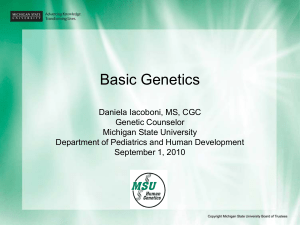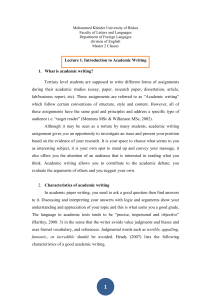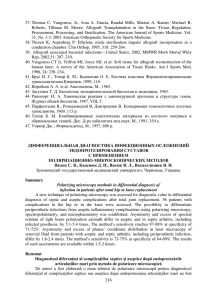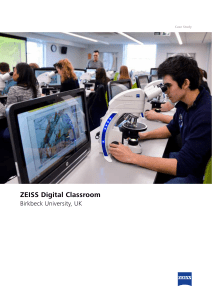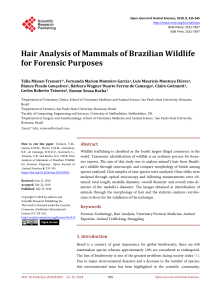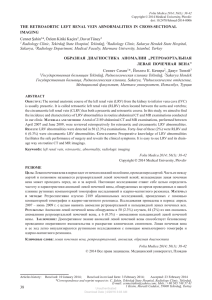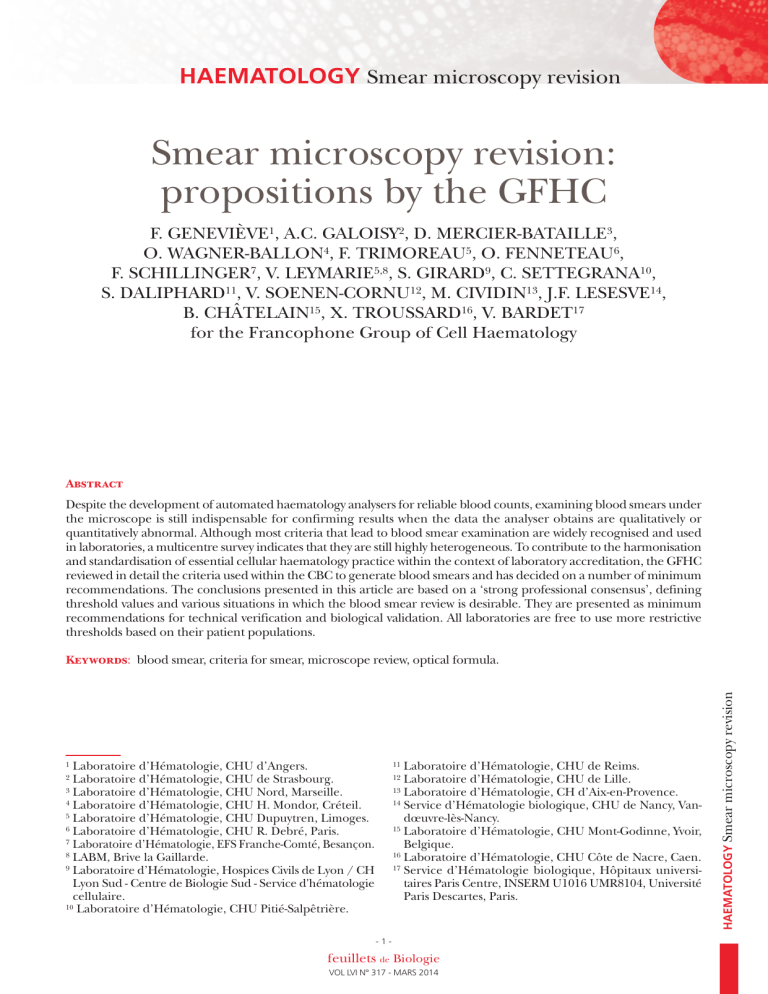
HAEMATOLOGY Smear microscopy revision Smear microscopy revision: propositions by the GFHC F. GENEVIÈVE1, A.C. GALOISY2, D. MERCIER-BATAILLE3, O. WAGNER-BALLON4, F. TRIMOREAU5, O. FENNETEAU6, F. SCHILLINGER7, V. LEYMARIE5,8, S. GIRARD9, C. SETTEGRANA10, S. DALIPHARD11, V. SOENEN-CORNU12, M. CIVIDIN13, J.F. LESESVE14, B. CHÂTELAIN15, X. TROUSSARD16, V. BARDET17 for the Francophone Group of Cell Haematology Abstract Despite the development of automated haematology analysers for reliable blood counts, examining blood smears under the microscope is still indispensable for confirming results when the data the analyser obtains are qualitatively or quantitatively abnormal. Although most criteria that lead to blood smear examination are widely recognised and used in laboratories, a multicentre survey indicates that they are still highly heterogeneous. To contribute to the harmonisation and standardisation of essential cellular haematology practice within the context of laboratory accreditation, the GFHC reviewed in detail the criteria used within the CBC to generate blood smears and has decided on a number of minimum recommendations. The conclusions presented in this article are based on a ‘strong professional consensus’, defining threshold values and various situations in which the blood smear review is desirable. They are presented as minimum recommendations for technical verification and biological validation. All laboratories are free to use more restrictive thresholds based on their patient populations. Laboratoire d’Hématologie, CHU d’Angers. Laboratoire d’Hématologie, CHU de Strasbourg. 3 Laboratoire d’Hématologie, CHU Nord, Marseille. 4 Laboratoire d’Hématologie, CHU H. Mondor, Créteil. 5 Laboratoire d’Hématologie, CHU Dupuytren, Limoges. 6 Laboratoire d’Hématologie, CHU R. Debré, Paris. 7 Laboratoire d’Hématologie, EFS Franche-Comté, Besançon. 8 LABM, Brive la Gaillarde. 9 Laboratoire d’Hématologie, Hospices Civils de Lyon / CH Lyon Sud - Centre de Biologie Sud - Service d'hématologie cellulaire. 10 Laboratoire d’Hématologie, CHU Pitié-Salpêtrière. Laboratoire d’Hématologie, CHU de Reims. Laboratoire d’Hématologie, CHU de Lille. 13 Laboratoire d’Hématologie, CH d’Aix-en-Provence. 14 Service d’Hématologie biologique, CHU de Nancy, Vandœuvre-lès-Nancy. 15 Laboratoire d’Hématologie, CHU Mont-Godinne, Yvoir, Belgique. 16 Laboratoire d’Hématologie, CHU Côte de Nacre, Caen. 17 Service d’Hématologie biologique, Hôpitaux universitaires Paris Centre, INSERM U1016 UMR8104, Université Paris Descartes, Paris. 1 11 2 12 -1- feuillets de Biologie VOL LVI N° 317 - MARS 2014 HAEMATOLOGY Smear microscopy revision Keywords: blood smear, criteria for smear, microscope review, optical formula. 1. - OBJECTIVE AND METHODS three private laboratories, seven multipurpose laboratories at general hospitals and 29 haematology laboratories at university hospitals. Importantly, all of the leading automated haematology analysers on the market were represented. Despite the development of automated haematology analysers for blood counting, analysing blood smears under the microscope is still indispensable when analyser results are qualitatively or quantitatively abnormal, or when results need to be confirmed. In these cases, the smear provides information that the analyser alone cannot deliver, allowing final technical validation of these results. An example would be when an analyser’s flags indicate difficulties identifying cells or when interferences have been detected. Moreover, it is normally the cells’ morphological analysis that allows the clinician to develop a diagnostic hypothesis. In the end, some of these hypotheses can be rejected, and sometimes observing morphological abnormalities can lead to a more accurate diagnosis. The data obtained from the analysers were analysed individually and taking the following into account: information related to the patient and information of the blood count, the normal reference values published for children and adults (8-13), the threshold values recognised as probably pathological for the cell count and leukocyte differential, and the qualitative flags common in the various analysers (triggered according to the settings of the respective supplier). The initial conditions and followup situations were also considered and the utility of a ‘delta check’ was discussed. The group was able to count on the experience of numerous paediatric centres, so that the particularities of children were also examined. Finally, these prospective and retrospective evaluations have helped to validate certain criteria that had become controversial, either because of their impact on the number of smears that were generated or because of a lack of consensus within the group. HAEMATOLOGY Smear microscopy revision Even though most of the criteria that lead to a blood smear examination are widely recognised and used in laboratories, they are still very heterogeneous. The attitudes and decision thresholds may indeed vary, depending on different factors: the number of CBCs that have been made, the profile of the individual patient, experience and habits of the biologists, the type of haematology analyser used, the availability of human resources, expectations of the clinicians, etc. In recent years, the efforts for rationalising and standardising laboratory practice, driven by medico-economic constraints and the increasing clinical role of the biologists, have led to the publication of recommendations in international literature (1-7). Although these publications may present some differences, they all share the same objective of optimal care for the patients by means of a clinical review of the blood smear. Actually, the thresholds used may differ considerably - particularly the values considered as normal (8-13). The group’s conclusions are based on strong professional agreement. They are shown here, after defining the thresholds and situations in which a blood smear review is desirable. They are proposed by the GFHC as minimal recommendations, formulated for the technical verification and the biological validation and can be applied to a range of laboratories (private, CHG or CHU), regardless of the type or brand of haematology analyser used. The conclusions take into consideration recommendations concerning the pre-analytical phase of the CBC (15, 16) and good knowledge of the analyser and its specifications according to ISO 15189 (17). They can also be adapted in individual laboratories to better suit daily practice. In order to contribute to this harmonisation and standardisation of the practices in cellular haematology and to help biologists during the accreditation process, the GFHC decided to review in detail the criteria used to generate blood smears and from this make some minimum recommendations. This idea was initiated back in 2002 by Berend Houwen and finished in 2005 with the recommendations of the group consensus of the International Society for Laboratory Hematology (ISLH) (1). In this spirit, a group formed by 17 experts in cell haematology, adult or paediatric, from university hospitals or general hospitals, met for three days in May and June of 2013 to examine the criteria related to smear review. 2. - DEFINITIONS OF TERMS AND CONVENTIONS 2.1. Initial situation and follow-up The terms ‘initial’ or ‘first time’ and ‘follow up’, often used in the recommendations published may represent nuances that must be taken into consideration when setting up a laboratory’s standardised procedures. As far as the technical audit process or biological validation that leads to a blood smear’s examination, we define a situation as ‘initial’ in the following three cases: a) absence of a previous CBC result for a patient; b) an abnormality that was not present in the previous CBC; and c) a situation in which the previous smear review dates back > 90 days (adults) or > 30 days (children). In all three cases, the abnormal result may be observed in the patient for the first time, reflecting a new or progressive clinical situation, and the smear review may help to diagnose the patient or clarify the situation. In the third case, the observed The reflections and proposals by the group are based on two main criteria: the first is a critical analysis of existing and published recommendations (1-7). The second is a study of the laboratory practice of a group of 39 laboratories that perform a large number of blood smears per day and agreed to answer a questionnaire in which they explain the threshold values and the criteria used to produce blood smears (http://www.gfhc.fr/fr/actualites/theme-4etudes-en-cours/id-69-recommendations-on-the-criteriafor-review-of-frottissanguins). These laboratories included -2- feuillets de Biologie VOL LVI N° 317 - MARS 2014 Smear microscopy revision analyser result without any quantitative or qualitative abnormality can be validated. Nevertheless, at this age, qualitative alarms by the analysers are very frequent and a blood smear review is usually requested. abnormality may already be known (chronic disease), but a new smear review is justified after a certain time to detect possible changes in the patient’s haematological status (e.g. the appearance of morphological abnormalities over time or a small number of blasts circulating in the blood stream in case of MDS). By agreement, the term ‘last case’ means the last analysis in which the blood smear was reviewed and not just the last time the CBC was measured. 3.1.2. Prescribing physician or hospitalisation service When the questionnaire has been reviewed regarding the local smear review practice, the following situation has also been considered: when is it necessary to do a smear review if this is systematically requested by the physicians? A systematic smear review is needed for patients from the paediatric haematology-oncology unit that are unknown or without recent morphological information. This is due mainly to the fact that analysers usually have problems detecting lymphoblast cells when they are present in low numbers (18). Apart from this particular situation, a physician’s opinion is not considered a criterion that must lead to a smear review. The biologist in the lab can trust the result of the analyser if all other smear review criteria are being followed and the performance of the analyser has been quality-controlled. If the same abnormality is noticed in two consecutives CBCs in an adult patient, this is usually linked to chronic disease. In such a case not performing a blood smear too often can be justified since it wouldn’t be necessary. For these abnormalities, the GFHC considers a maximum period of 90 days between two smear reviews a good compromise for validating CBC results. With children, the selected period is 30 days because here abnormal CBCs are more often related to acute clinical situations than to chronic incidents. Apart from the situations described above, a patient is considered to be having a ‘follow up’ examination and the clinical biological context is well identified by the biologist: in the absence of any new information or lack of systematic smear review, the CBC result may be validated without performing a new blood smear since, a priori, this would not offer any added value. 3.1.3. Permanent reference regarding information of the patient If an abnormality was identified for the first time in a patient, registering a permanent comment associated with that patient’s information can be useful for validating subsequent CBCs faster and more securely. An example would be the presence of cryoglobulins or WBC agglutinations, which are important in terms of the cell count. A permanent message associated with the patient that points out this situation can be used as a criterion for performing the analysis at 37°C or a smear review next time. 2.2. Child and adult An adult is defined as an individual aged 15 or over. A child is less than 15 years old. 3. RECOMMENDATIONS BY THE GFHC REGARDING SMEAR MICROSCOPY REVIEWS The indications below were established by studying independently every type of abnormality or situation. Depending on the different kinds of abnormalities or on other indications reported by the haematology analysers, the laboratory biologist can consider these indications as making the study of morphological abnormalities more sensitive and specific. This type of prescription necessarily involves smear review and an explicit comment to the prescribing physician in return. In the absence of abnormal cells, the analyser cell count, which is more precise, is preferred to the manual count. If the prescription asks for schizocytes, the search for them can be performed differently. The responsible biologist can decide whether or not there is a need to perform a blood smear. This will depend on the laboratory and whether its analyser is capable of quantifying RBC fragments (19). If a schizocytes count is required in the end, this will be done in line with the recommendations published recently (20). 3.1. Recommendations regarding the patient information 3.1.1. Is it necessary to do a smear systematically depending on the age of the patient? A patient’s age is not a criterion for adults. With neonates, during the first week of life, smear revision is recommended at least at the time the first CBC is performed, due to the frequent erythroblastaemia (see also the section ‘Indications regarding the WBC diff’). In children younger than one year, performing a systematic smear review is recommended when an initial CBC is performed because most of the constitutional haematological pathologies appear during the first year of life and a blood counter does not always detect them. Outside of this context, an 3.1.5. Prescription of a blood smear after results were obtained from bone marrow or immunophenotyping analysis Blood smear review is recommended but not essential for a good interpretation or to complete the information of these analyses. A synopsis of the various criteria for smear review regarding the patient information is presented in Table 1. -3- feuillets de Biologie VOL LVI N° 317 - MARS 2014 HAEMATOLOGY Smear microscopy revision 3.1.4. Specific prescription of the morphological analysis Table 1: Indications for smear review regarding patient information. Adult No impact Children < 8 days, initial situation; < 12 months, specialised paediatric ward and initial situation Prescriber or hospital service Adult No impact Children Onco-haematology paediatric ward, first analysis Patient information Adult/Children Permanent reference (e.g. known cryoglobulins, known leukoagglutination, etc.) Specific prescription Adult/Children Specific prescription of smear review Prescription associated with myelogram or immunophenotyping Searching for schizocytes: mode-specific for each laboratory Age increase the PLT count (cryoglobulins, fragments, cell debris...) (20). If the count is considered correct, the blood smear can guide in the diagnosis but it is not mandatory, since it doesn’t provide formal argumentation for asserting the existence of a myeloproliferative syndrome (megakaryocyte fragments, an excess of falsely classified basophils, etc.). Results showing thrombocytosis that have already been reported don’t require a new blood smear review. 3.2. Recommendations regarding cell count results 3.2.1. WBC count a) Quantitative flags In an initial situation, the WBC count is not a good criterion for deciding whether a blood smear is required or not. The qualitative or quantitative alarms displayed by the analyser are more useful. In cases of leukopenia or leucocytosis, analysing the sample tube in differential mode is recommended if this is not performed routinely. Thrombocytopenia In case of thrombocytopenia (PLT < 150 x 109 cells/L) observed either in an initial situation or in the follow-up of the patient, the first thing to be done is to look for interferences that may cause a falsely low count (clumps, fibrin, macroplatelets...) (20). According to the curves published by Berend Houwen (23), the delta-check used is 50% when compared with the previous result. In the event that no interferences are found, a blood smear review is mandatory when an adult presents less than 100 x 109 cells/L. Below this threshold abnormalities of higher clinical interest can be found. Of course, the biologist can always adjust this threshold to make it more restrictive, between 100 and 150 x 109 cells/L, especially when there are other abnormalities or cytopenias. When the smear is reviewed, the focus will be on searching for WBC abnormalities (malignant or reactive cells), RBC abnormalities (schizocytes, intracellular parasites, etc.) and PLT abnormalities. In children, the possibility of a constitutional PLT abnormality makes the 150 x 109 cells/L threshold for smear review preferable. HAEMATOLOGY Smear microscopy revision In a follow-up situation in the particular case of patients under myelo-suppressive chemotherapy, not reporting the WBC differential is acceptable in the case of leukopenia < 1.0 x 109 cells/L, if there is an agreement between the laboratory and the prescriber. Below this threshold, if the clinical monitoring requires the absolute neutrophil count, the result of the analyser can be reported, mentioning in the report that the WBC count is the one delivered by the analyser. For those patients with haematological diseases, the recovery of a WBC count ≥ 1.0 x 109 cells/L indicates the need for a blood smear review in order to check for the presence of abnormal morphologies. These cells would indicate a bad response of the patient’s treatment. In this case, the biologists report the most suitable result - either the one obtained by the analyser or the one obtained manually under the microscope, depending on the presence or absence of abnormal cells. b) Qualitative flags Any flag reported by the analyser that reflects a lack of reliability of the WBC count necessitates the interpretation and validation of the results in line with the guidelines provided by the manufacturer. The smear review is useful for identifying certain interferences and for assisting in the result’s technical validation (21, 22). MPV abnormality The mean platelet volume (MPV) is not part of the parameters to be reported systematically in the CBC (14), although most analysers determine it. The MPV value is highly variable depending on the type or brand of haematology analyser (24), but in general a value between 6 and 7 fL seems to correspond to the lower limit for all the devices that are currently on the market. In case of an unknown patient with thrombocytopenia (< 150 x 109 cells/L) and an MPV < 7 fL, a smear is potentially useful, also in case of an MPV beyond the normal higher threshold (as set by the supplier), or if any other parameter that reflects the presence of large platelets is reported. 3.2.2. PLT count and PLT index a) Quantitative flags Thrombocytosis In case of thrombocytosis (PLT > 450 x 109 cells/L) observed in an initial situation, the smear review can be useful for detecting interferences that could falsely -4- feuillets de Biologie VOL LVI N° 317 - MARS 2014 Smear microscopy revision b) Qualitative flags and abnormalities in the graphics displayed by the analyser regenerative” (25), the GFHC recommends using > 120 x 109 cells/L to review the blood smear. In case of unknown severe anaemia (HGB < 8 g/dL), the review of the blood smear is essential for looking for morphological abnormalities or abnormal cells. If the abnormality is already known, the blood smear review doesn’t provide any added value if the last smear review doesn’t exceed 90 days. Suspicion of PLT clumps Independently of the PLT count reported by the analyser, the operator must check for the presence of PLT clumps in the sample and then look for PLT aggregation either by examining a stained blood smear or by examination under the phase contrast microscope with a drop of fresh blood. In case of clumps, the result of the PLT count reported by the analyser has to be replaced by the note “clumps”. If the clinician indicates that the result delivered has to be the one provided by the analyser, the biologist in the laboratory has to add it as a comment so as not to mistake this result as an exact result. This action will be the same in case the flag is repeated in the next set of results. In children, a reticulocyte count is recommended in case of a normo- or macrocytic anaemia with HGB < 9 g/dL. A morphologic review of the blood smear is recommended in any kind of anaemia < 9 g/dL, both in an initial situation or when the delta check regarding the previous result is a decreasing value > 25%. The review of the blood smear doesn’t provide any added value if the last smear revision was performed less than 30 days previously. If no clumps or any other interference that could reduce the value of the PLT count are observed, the PLT count reported by the analyser can be delivered and the verification that has taken place has to be recorded. If the flag is repeated in the following samples, the process of looking for PLT clumps can be avoided and the analyser result can be delivered. Abnormalities in the MCV Other alarms or abnormalities of the PLT graphics Most of those related to the PLT count are connected to the distribution of RBC. The recommendations regarding the preparation of a blood smear in these cases are described below. 3.2.3. RBC count, HGB and RET a) Quantitative abnormalities Polycythaemia In case of microcytosis (MCV < 70 fL between six months and two years; < 72 fL between two and six years; < 75 fL beyond six years), the study of RBC morphology is useful in the case of an initial situation for guiding the diagnosis of a possible constitutional haemoglobin disorder. Interpreting the HGB values and other RBC parameters would be more useful than just interpreting the MCV in order to gain information about iron deficiency, inflammatory balance or even the presence of a haemoglobinopathy, which could justify haemoglobin electrophoresis to obtain a confirmation. In cases of a result showing polycythaemia (HGB > normal with a given gender and age), the smear review doesn’t provide any additional value, neither in the initial situation nor with the follow-up tests. Anaemia Finding anaemia may help in certain situations to detect a pre-analytical or analytical problem, or a pathology in the patient. The recommendation, after verifying that there is an absence of coagulation in the tube, is normally guided by the variation shown in other parameters (MCV, WBC, PLT, RET...). Anisocytosis In adults, when no haemorrhage is detected in the patient, in case of normo- or macrocytic anaemia observed with HGB < 10 g/dL, either in an initial situation or a follow-up with a decreasing difference of > 25% to the previous result, first checking the reticulocyte count is recommended. This approach is essential for quickly detecting haemolytic anaemia situations, and then, the blood smear is recommended in case of hyper-reticulocytosis. Even when the French Haematology Society (Société Française d’Hématologie) recommends a number of reticulocytes > 150 x 109 cells/L to qualify an anaemia as “clearly In case of an initial situation and when no transfusion has been performed and a dual RBC population is present, the GFHC’s recommendation (like ISLH) is to review the blood smear in those cases where there is an important abnormality within the RBC distribution. In addition to searching for morphological abnormalities, the result is to be interpreted with an eye to the RBC’s distribution graphic and whether or not an associated anaemia exists. In these cases, the MCV loses its ability to be informative, and only a comment ‘anisocytosis with macrocytosis’, and/or ‘anisocytosis with microcytosis’ can -5- feuillets de Biologie VOL LVI N° 317 - MARS 2014 HAEMATOLOGY Smear microscopy revision In children less than 6 months old, the MCV is not a parameter that provides enough information for deciding decide on a blood smear review. Beyond that age, in an initial situation and after eliminating any artefact, a macrocytosis (MCV > 85 fL from six months to two years; > 95 fL from two to 15 years, and > 105 fL in adults) justifies the reticulocyte count and the smear review to find the aetiology. In case of a future CBC test, and always when the previous smear review doesn’t yet exceed 90 days in adults or 30 days in children, the review of a blood smear based on this single criterion is not of real interest. However, important variations in the MCV will be considered (> 5%) for detecting labelling errors or a pre-analytic issue (collection in perfusion). be added to the results. Repeating the examination of a blood smear during the follow-up period is not useful. of an initial situation and when no transfusion has been performed. Abnormalities in the MCHC In case of an abnormally high MCHC value (threshold between 36 and 37 g/dL, depending on the analyser), the first step is to look for possible interferences (22). If these are not present, a blood smear review is recommended to look for a corpuscular abnormality (such as spherocytosis). Triggering the smear review in case of a low MCHC value is redundant as this may be caused by the HGB value and/or the MCV. RBC lysis resistance The smear review is necessary for analysing RBC morphology and for checking the WBC differential count because the cell count delivered by the analyser may potentially be wrong. Rejection of the reticulocyte count or abnormality in the reticulocyte graphic A critical analysis of the reticulocyte graphic in case of an abnormality or flag delivered by the analyser is important for deciding on the reticulocyte count review under the microscope stained with cresyl violet. In cases where analysers provide this information, it is important to verify the coherence between the absolute reticulocyte count and their level of fluorescence. If there is hyperreticulocytosis > 120 x 109 cells/L, performing a blood smear to look for RBC abnormalities is recommended. A synopsis of the various criteria for smear review regarding cell count abnormalities is presented in Table 2. Abnormalities in the reticulocyte count In an initial situation, if the number of reticulocytes is > 120 x 109 cells/L, this corresponds to an increment in the erythropoiesis in the bone marrow, and a blood smear is recommended to find possible abnormalities. This recommendation is independent of the associated HGB value, which can be normal or not, e.g. in case of a well-compensated haemolytic anaemia. b) Qualitative abnormalities 3.3. Recommendations regarding the WBC differential 3.3.1. Presence of abnormal cells both in the latest and the previous count In cases where patients present malignant cells, which have been detected also by the previous CBC + DIFF, it is not enough to report the CBC + DIFF delivered by the analyser without having performed a blood smear (this ‘Fragments’ flag The blood smear review is recommended in case this flag is associated with anaemia and/or thrombocytopenia. Dual RBC population This flag is generally associated with an important anisocytosis (see above), justifying the smear review in case Table 2: Indications for a smear review in terms of the cell count. WBC (x 109 cells/L) Adults/Children Patients with blood malignancies, aplastic recovery (leukocytes ≥ 1.0 in the actual result and < 1.0 in the previous one) Adults < 100, in an initial situation > 450, in an initial situation Children < 150, in an initial situation Adults/Children < 7, in an initial situation with PLT < 150 x 109 cells/L > upper limit (supplier), in an initial situation with PLT < 150 x 109 cells/L Adults < 8, in an initial situation < 10, in an initial situation with reticulocyte count >120 x 109 cells/L Children < 9, in an initial situation Adults > 105, in an initial situation < 75, in an initial situation Children > 85 (six months to two years), > 95 (two to 15 years), in an initial situation < 70 (six months to two years), < 72 (two to six years), < 75 (from six years onwards), in an initial situation PLT (x 10 cells/L) 9 HAEMATOLOGY Smear microscopy revision MPV (fL) HGB (g/dL) MCV (fL) MCHC (g/dL) Adults/Children > normal upper limit, when there is no interference RDW-CV (CV %) Adults/Children > 22%, in an initial situation, from a known RBC transfusion setting Reticulocytes (x 109 cells/L) Adults/Children > 120, in an initial situation -6- feuillets de Biologie VOL LVI N° 317 - MARS 2014 Smear microscopy revision c) Eosinophilia also applies when the result is accompanied by a comment indicating that the patient is known and presents pathological cells). If the blood smear examination shows a persistence of malignant cells, the WBC differential count has to be performed from the smear under the microscope. In the particular case of monitoring a patient with chronic lymphocytic leukaemia, the result delivered by the analyser is preferred, because there is always the risk of overestimating non-lymphocytic populations under the microscope. In situations with other chronic lymphoid disorders related to small mature cells, the normal and abnormal lymphoid cells can be grouped in the lymphocyte count, and the result delivered has to be accompanied by a comment stating a persistence of pathological lymphoid cells. In an initial situation, a blood smear review is needed when eosinophilia exceeds 1.5 x 109 cells/L. The smear review may allow the detection of lymphoma cells – certain lymphomas (mainly T-lymphomas) that can be associated with eosinophilia (29). In case of a follow-up the smear doesn’t provide any additional information. d) Basophilia In an initial situation, when basophils exceed 0.3 x 109 cells/L or represent > 3% of the WBC, smear review is recommended to look for abnormalities that may point to a myeloproliferative syndrome or the presence of abnormal leukocytes, which some analysers may potentially misclassify as basophils (30). In case of a follow-up, a smear review is not necessary. 3.3.2. Presence of NRBC Whether or not they are recorded by the analyser, the presence of NRBC circulating in the blood stream (except for neonatal patients) is a sign of a pathological situation and it justifies a blood smear review to look for abnormalities in the other cell lines. In case the analyser does not quantify the NRBC, they will have to be counted and subtracted from the WBC count to correct this value. The presence of NRBC in the previous analysis of a known patient justifies analysis in a specific mode of the analyser that allows NRBC detection (specific channel). A blood smear is not necessary for follow-ups of these patients. However, if the analyser is not able to perform this count, this will justify a microscopy count. e) Lymphocytosis In an initial situation with adult patients, a blood smear review to look for abnormal cells (malignant or reactive) is needed in case of > 5 x 109 lymphocytes/L. For children, the lymphocyte thresholds proposed are 11 x 109 cells/L (< two years); 9 x 109 cells/L (two to six years); 6 x 109 cells/L (six to 12 years). If no abnormal cells are present, the count provided by the analyser is preferred to the microscopy result. In case a lymphocytosis is newly detected in a follow-up after former inconspicuous tests, a smear is recommended if the last CBC + DIFF count was performed over 90 days ago for adult patients or 30 days previously for children. 3.3.3. Presence of a quantitative abnormality in a specific WBC population a) Neutropenia In case of neutropenia (< 1.5 x 109 cells/L observed in an initial situation), a blood smear must be performed to detect potentially false neutropenia due to agglutination (26), search for pathological cells or detect morphological abnormalities. A technique of leukocyte concentration or an automated microscope may be used to achieve a more sensitive search for abnormal cells. In case no abnormality is detected in the blood smear, delivering the analyser count is preferred. This is due to the inaccuracies related to rare event cell populations when counting only 100 cells (27). In case a CBC + DIFF was performed previously, a blood smear is only needed if the previous one dates back more than 90 days with adult patients, especially if neutropenia increases (a difference of 30% is proposed) or more than 30 days with children. g) Monocytosis The blood smear review is recommended in case of a monocytosis > 1.5 x 109 cells/L regardless of the patient’s age when it is an initial situation. It helps to visually verify the monocytosis because a variety of situations can make monocyte identification difficult for an analyser (myeloperoxidase deficiency, presence of abnormal cells located near the monocyte cluster, monocyte activation during severe sepsis, etc.) (28). Furthermore, the blood smear review makes it possible to look for morphological abnormalities and/or malignant cells that can provide information as to whether it relates to a chronic or an acute monocyte pathology. If, during the follow-up of a patient, a monocytosis > 1.5 x 109 cells/L persists for over 30 days, it performing a new blood smear review is also recommended. This can provide information on abnormalities such as chronic myelomonocytic leukaemia or juvenile myelomonocytic b) Neutrophilia Contrary to what is said by the ISLH, performing a smear in a case of neutrophilia, independently of its importance, is not considered necessary if it remains an isolated finding. In this case the smear review doesn’t add any value to the result delivered by the analyser and there is no morphological interference that could be caused by this type of abnormality (28). -7- feuillets de Biologie VOL LVI N° 317 - MARS 2014 HAEMATOLOGY Smear microscopy revision f) Lymphocytopenia This situation is a relatively frequent condition, but identifying its cause by looking at the blood smear is too rare an occasion to make this a criterion for blood smear review. The in vitro lymphocyte agglutination caused by EDTA is rather exceptional and remains without clinical consequences (31). leukaemia. The monocytosis that occurs during a patient’s hospitalisation is usually reactive and transitory (for example during a surgery); it justifies a morphological control in case it is an important monocytosis (the actual threshold value has to be defined by each laboratory). Abnormal WBC graphic, without flag In case of a bad separation of the WBC populations, and every time such an abnormality is presented, a blood smear has to be performed. A synopsis of the various criteria for smear review regarding WBC differential abnormalities is presented in Table 3. h) Monocytopenia An absolute monocytopenia is usually always observed in case of hairy cell leukaemia and its findings on the blood analyser should be, theoretically, a good criterion for initiating smear review looking for pathological cells. However, in most cases in daily practice, the analysers count hairy cells wrongly and the automated count doesn’t report monocytopenia. Therefore, finding monocytopenia in an adult patient should encourage the biologist to look for hairy cells in the blood smear. 4. DISCUSSION The recommendations for blood smear review and reporting of the haematological results have been derived from the reflection by the GFHC group and coordinated by its experts. They have been established by considering the quantitative and qualitative abnormalities of the CBC individually and guided by two objectives: to maintain high diagnostic sensitivity while keeping the number of smears that will have to be generated under control. The consensus of the thresholds should help avoid reviewing an insufficient number of smears, a situation that might lead to ignorance of analytical errors or pathological conditions, while on the other hand it should also help prevent reviewing an excessive number of smears, which would increase cost (reagents, time of both staff and biologist) and be a potential source of error (decrease of the critical analysis level and vigilance threshold of the observer). 3.3.4. Qualitative flags and abnormalities in the WBC graphics ‘Left shift’ flag In this case a blood smear review and manual count are not necessary. The diffraction index, if provided by the analyser, allows the detection of hyposegmentation or hypogranularity, which is interesting for detecting dysplasia. ‘Immature Granulocytes’ flag In an initial situation or patient follow-up, this alarm requires a blood smear if the analyser cannot produce an IG count. If the analyser is capable of performing the IG count according to the manufacturer’s recommendations, a blood smear is recommended only in an initial situation and not during the patient’s follow-up. Publishing recommendations is bound to create both frustration and controversy, but it has to be kept in mind that their task is to represent a basis that can be applicable for the majority. In the opinion of the GFHC, these practical recommendations represent a minimalist approach to be adopted by the biologists when facing abnormal results in the CBC. Each recommendation has to be considered individually and one must be aware that missing out on a microscopy review represents a risk that may be greater than that when ignoring critical information for the ‘Blasts?’ and ‘Abnormal lymphocytes?’ flag These flags require a blood smear review each time. In case no abnormal cells are present (neither reactive nor malignant), the count given by the analyser is preferred. HAEMATOLOGY Smear microscopy revision Table 3: Indications for smear review in terms of the results of the WBC differential. Former result Adults/children Presence of malignant cells, as observed with the former result Presence of NRBC, as observed with the former result (if they are not counted automatically by an analyser) NRBC Adults/children NRBC have been detected by the analyser, in an initial situation or every time if they are not counted automatically by the analyser Neutrophils Adults/children < 1.5 x 109 cells/L, in an initial situation Eosinophils Adults/children > 1.5 x 109 cells/L, in an initial situation Basophils Adults/children > 0.3 x 109 cells/L and/or > 3%, in an initial situation Adults > 5 x 109 cells/L, in an initial situation Children > 9 x 109 cells/L (two to six years), > 6 x 109 cells/L (six to 12 years), > 4 x 109 cells/L (> 12 years), in an initial situation Adults/children > 1.5 x 109 cells/L, in an initial situation > 1.5 x 109 cells/L, if persistent for more than 30 days > a threshold, which is to be defined for each laboratory when monocytosis occurs during hospitalisation Lymphocytes Monocytes -8- feuillets de Biologie VOL LVI N° 317 - MARS 2014 Smear microscopy revision biological validation or the prescribing physician. This risk cannot be assumed to be zero, at least not for results between values considered ‘normal’ and the thresholds selected by the GFHC. But, as assessed by the GFHC and other groups, commonly accepted rules may be considered acceptable if the rate of ‘false negatives’ remains < 5%. The biologists are free to implement a more restrictive control of these thresholds by using lower ‘pathological’ thresholds than the ones proposed here. These recommendations are meant as a basis that can be susceptible to adaptations according to the examination structure, the recruitment specificity of each laboratory or the use of expert systems. The latter allow the creation of multiple rules that permit a more sensible detection of abnormal situations with a better management of blood smears. Acknowledgements The authors of this paper wish to thank the following individuals for participating actively in the questionnaire about the smear review practices in the laboratory: B. Berdin (Laval), A. Bouvier (Le Mans), E. Bichier (Saumur), C. Brumpt (Paris), M.P. Callat (Rouen) A. Clabé (La Réunion), C. Fossat (Marseille), F. Dubois-Galopin (Toulouse), E. Duchayne (Toulouse), P. Felman (Lyon), J. Guy (Dijon), J.P. Hurst (Le Havre), M. Imbert (Créteil), F. Le Baron (Valenciennes), P. Lemaire (Paris), P. Lepelley (Lille), M. Mallet (Caen), K. Maloum (Paris), V. Marion (Brest), J.M. Martelli (Meulan), C. Mayeur-Rousse (Strasbourg), B. Perez (Le Mans), C. Rapatel (Clermont-Ferrand), S. Wuilleme (Nantes), M. Zandecki (Angers). Conflict of interests: none. (1) Barnes PW, McFadden SL, Machin SJ, Simson E. The international consensus group for hematology review: suggested criteria for action following automated CBC and WBC differential analysis. Lab Hematol 2005 ; 11 : 83-90. (2) Galloway MJ, Osgerby JC. An audit of the indications for the reporting of blood films: results from the National Pathology Benchmarking Study. J Clin Pathol 2006 ; 59 : 479-81. (3) Bain BJ. Diagnosis from the blood smear. N Engl J Med 2005 ; 353 : 498-507. (4) Gulati G, Song J, Florea AD, Gong J. Purpose and criteria for blood smear scan, blood smear examination, and blood smear review. Ann Lab Med 2013 ; 33 : 1-7. (5) Peterson P, Blomberg D, Rabinovitch A, Cornbleet P. Physician review of the peripheral blood review: when and why. Lab Hematol 2001 ; 7 : 175-9. (6) Woo HY, Shin SY, Park H, Kim YJ, Kim HJ, Lee YK, Chae SL, Chang YH, Choi JR, Han K, Cho SR, Kwon KC. Current status and proposal of a guideline for manual slide review of automated complete blood cell count and white blood cell differential. Korean J Lab Med 2010 ; 30 : 559-66. (7) Bain BJ. The peripheral blood smear. Cecil Medicine, 24th edition. Philadelphia : Saunders Elsevier ; 2011 : chap. 160. (8) Troussard X, Vol S, Cornet E, Bardet V, Couaillac JP, Fossat C, Luce JC, Maldonado E, Siguret V, Tichet J, Lantieri O, Corberand J, for the French-Speaking Cellular Hematology Group (Groupe Francophone d'Hématologie Cellulaire, GFHC). Full blood count normal reference values for adults in France. J Clin Pathol 2013 Oct 29 (sous presse). (9) Bates I, Lewis SM. Reference ranges and normal values, Dacie and Lewis Practical Haematology, eleventh edition. Edinburgh : Churchill Livingstone Elsevier ; 2012 : p. 11. (10) Simpkin PS, Hinchliffe RF. Reference values. Pediatric Hematology, third edition. Oxford : Blackwell Publishing ; 2006 : p. 792. (11) Skubitz KM. Wintrobe's Clinical Hematology, twelfth edition, volume 1. Edited by Greer JP, Foerster J, Lukens JN, Rodgers GM, Paraskevas F, Glader B. Philadelphia : Lippincott Williams & Wilkins ; Normal Blood leukocyte concentration (95 % confidence limits) ; 2009 : p.186. (12) Brugnara C. Reference Values in Infancy and Childhood. Nathan and Oski's Hematatology of Infancy and Childhood, seventh edition. Philadelphia : Saunders Elsevier ; 2009 : p. 1769. (13) Herklotz R, Lüthi U, Ottiger C, Huber AR. Metaanalysis of reference values in hematology. Ther Umsch 2006 ; 63 : 5-24. (14) Agence Nationale d'Accréditation et d'Évaluation en Santé (ANAES). Lecture critique de l'hémogramme: valeurs seuils à reconnaître comme probablement pathologiques et principales variations non pathologiques. Paris : Service des Références Médicales ; 1997 ; http://has.sante.fr/portail/upload/docs/application /pdf/Hemogram.pdf (15) COFRAC. Guide technique d'accréditation en biologie médicale. Document SH GTA 01. Paris : COFRAC ; 2011 ; http://wwww.cofrac.fr/documentation/SH-GTA-01 (16) Trimoreau F, Gachard N, Leymarie V, Frébet E, Perroud P, Feuillard J. Étapes préanalytiques pour la numération et cytologie sanguine. EMC-Biologie médicale. Paris : Elsevier Masson ; 2011 : p. 1-10. (17) Buttarello M. Quality specification in haematology: the automated blood cell count. Clin Chim Acta 2004 ; 346 : 45-54. (18) Bain BJ. Blood cells: a practical guide, 4th edition Oxford : Wiley-Blackwell ; 2006. (19) Lesesve JF, Asnafi V, Braun F, Zini G. Fragmented red blood cells automated measurement is a useful parameter to exclude schistocytes on the blood film. Int J Lab Hematol 2012 ; 34 : 566-76. (20) Zini G, d'Onofrio G, Briggs C, Erber W, Jou JM, Lee SH, McFadden S, Vives-Corrons JL, Yutaka N, Lesesve JF. International Council for Standardization in Haematology (ICSH). ICSH recommendations for identification, diagnostic value,and quantitation of schistocytes. Int J Lab Hematol 2012 ; 34 : 107-16. -9- feuillets de Biologie VOL LVI N° 317 - MARS 2014 (21) Zandecki M, Genevieve F, Gerard J, Godon A. Spurious counts and spurious results on haematology analysers: a review. Part I: platelets. Int J Lab Hematol 2007 ; 29 : 4-20. (22) Zandecki M, Genevieve F, Gerard J, Godon A. Spurious counts and spurious results on haematology analysers: a review. Part II: white blood cells, red blood cells, haemoglobin, red cell indices and reticulocytes. Int J Lab Hematol 2007 ; 29 : 21-41. (23) Houwen B. Random errors in haematology tests: a process control approach. Clin Lab Haem 1989 ; 12 : 157-70. (24) Latger-Cannard V, Hoarau M, Salignac S, Baumgart D, Nurden P, Lecompte T. Mean platelet volume: comparison of three analysers towards standardization of platelet morphological phenotype. Int J Lab Hematol 2012 ; 34 : 300-10. (25) Lévy JP, Varet B, Clauvel JP, Lefrère F, Bezeaud A, Guillin MC. Hématologie et transfusion, 2ème édition. Paris : Elsevier Masson ; 2008 : p. 127. (26) Lesesve JF, Haristoy X, Lecompte T. EDTA-dependent leukoagglutination. Clin Lab Haem 2002 ; 24 : 67-9. (27) Rümke C. The statistically expected variability in differential leukocyte counting. Differential leukocyte countings. Sokie, Illinois: College of American Pathologists ; 1979 : p. 39-45. (28) Genevieve F, Godon A, Marteau-Tessier A, Zandecki M. Anomalies et erreurs de détermination de l'hémogramme avec les automates d'hématologie cellulaire Partie 2. Numération et formule leucocytaires. Ann Biol Clin (Paris) 2012 ; 70 : 141-54. (29) Kahn JE, Legrand F, Capron M, Prin L. Hyperéosinophilies et syndromes hyperéosinophiliques. EMCHématologie. Paris : Elsevier Masson ; 2011 : p. 1-16. (30) Lesesve JF, Benbih M, Lecompte T. Accurate basophils counting: not an easy goal! Clin Lab Haem 2005 ; 27 : 143-4. (31) Lesesve JF, Haristoy X, Fischer B, Goupil JJ, Lecompte T. Agglutination in vitro EDTA-dépendante des lymphocytes. Ann Biol Clin (Paris) 2001 ; 59 : 497501. HAEMATOLOGY Smear microscopy revision Références Bibliographiques
